Ministry of Agriculture &
Farmers Welfare
Transforming Agricultural Finance
Enhancing KCC limit to ₹5 lakh
प्रविष्टि तिथि:
04 FEB 2025 5:33PM by PIB Delhi
Agriculture and Allied Activities sector in India
The ‘Agriculture and Allied Activities’ sector has long been the backbone of the Indian economy, playing a vital role in national income and employment. With nearly 46.1 per cent of the population engaged in agriculture and allied activities, ensuring financial security and accessible credit for farmers remains a top priority for the government. Recognizing this, the Union Budget 2025-26 introduces key measures to strengthen agricultural financing, particularly through the Kisan Credit Card (KCC) scheme.
The KCC scheme has been instrumental in fulfilling farmer’s financial needs. With a significant increase in the loan limit under the Modified Interest Subvention Scheme from ₹3 lakh to ₹5 lakh; this year’s budget underscores the government's commitment to empowering farmers and boosting agricultural productivity.
This article presents a comprehensive understanding of the KCC scheme and how it transforms agricultural credit accessibility in India.
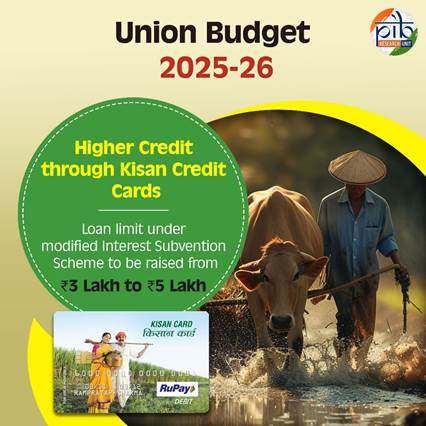
What is Kisan Credit Card Scheme
Safeguarding and ensuring hassle-free credit availability at a cheaper rate to farmers has been the top priority of the government. Accordingly, the Kisan Credit Card Scheme (KCC) was introduced for farmers to provide farmers with easy access to affordable credit for their agricultural needs so as to meet short term /long term cultivation requirements, postharvest expenses, consumption requirement etc.
How does KCC help Farmers?
The Kisan Credit Card (KCC) scheme is designed to provide farmers with adequate and timely credit to meet their diverse financial needs. It helps farmers access institutional credit easily, ensuring their financial stability and agricultural productivity. The scheme offers support for:
- Cultivation and post-harvest activities: Ensuring funds are available for cultivation and post-harvest costs.
- Marketing loans: Helping farmers bridge financial gaps until they sell their produce at competitive market rates.
- Household consumption needs: Offering financial support to meet essential household expenses, preventing dependency on informal lending sources.
- Working capital for farm assets: Assisting in the maintenance of essential farming equipment and infrastructure.
- Investment credit for allied activities: Expanding financial access to animal husbandry, dairying, fisheries, and other agricultural extensions.
Recognizing the importance of allied sectors, the KCC scheme was expanded in 2019 to include animal husbandry, dairying, and fisheries. Banks can provide collateral-free loans up to ₹1.60 lakh, ensuring financial security and fostering growth in these allied fields.
Understanding Short Term Loans
The Modified Interest Subvention Scheme (MISS) offers concessional Short-term Agri-loans to farmers for crop and allied activities, providing a 7% interest rate on loans up to ₹3.00 lakh, with an additional 3% subvention for timely repayment, reducing the effective rate to 4%. MISS also includes post-harvest loans against NWRs for small farmers with KCCs.
Ensuring Transparency
The Kisan Rin Portal (KRP) launched in September 2023 addresses key challenges in the MISS-KCC scheme. Previously, banks had to submit claims for Interest Subvention (IS) and Prompt Repayment Incentive (PRI) manually to the Reserve Bank of India (RBI) and NABARD, leading to significant delays and inefficiencies. The Kisan Rin Portal digitizes this process, ensuring farmers and lending institutions benefit from quicker, seamless transactions, improving access to credit for agricultural needs.
- Empowering Farmers with Seamless Access to Credit
- Benefiting Financial Institutions: Banks and Cooperatives
- Reaching the Grassroots: Training and Support
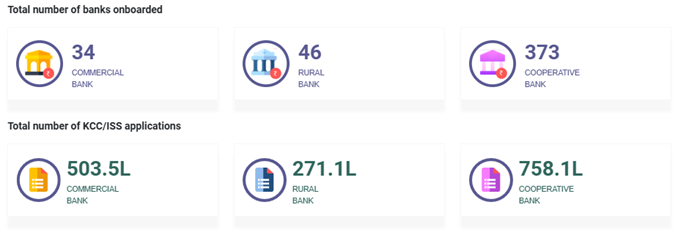
By 31 December 2024, it had processed claims worth ₹108336.78 crore including Interest Subvention (IS) and PRI. About 5.9 crore farmers that are currently getting benefitted under the MISS-KCC scheme, have been mapped through KRP.
Achievements of Agriculture sector
- As of March 2024, the country has 7.75 crore operational KCC accounts with a loan outstanding of ₹9.81 lakh crore.
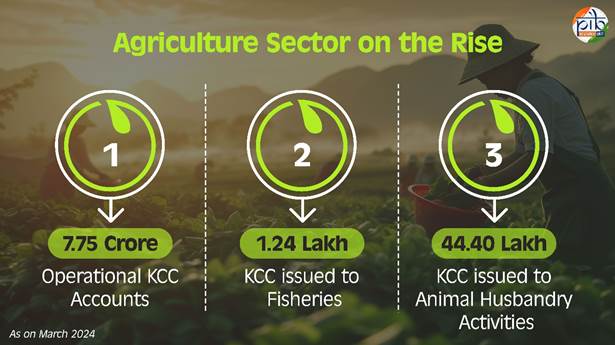
- 1.24 lakh KCC and 44.40 lakh KCC were issued to fisheries and animal husbandry activities, respectively.
- In the last 10 years, Rs 1.44 lakh Crore of Interest Subsidy has been released on Kisan Credit Card loans. It has risen nearly 2.4 times, from ₹6,000 Crore in 2014-15 to ₹14,252 crore in 2023-24.
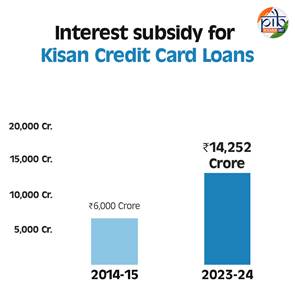
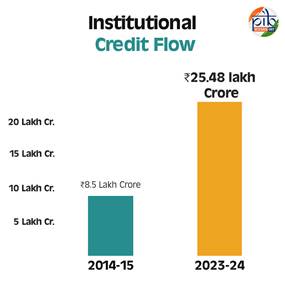
- Institutional credit flow to agriculture has risen nearly three times since 2014-15, rising from ₹ 8.5 lakh Crore to ₹ 25.48 lakh Crore in 2023-24. Short-term agriculture credit has more than doubled, increasing from ₹ 6.4 lakh Crore in 2014-15 to ₹ 15.07 lakh Crore in 2023-24.
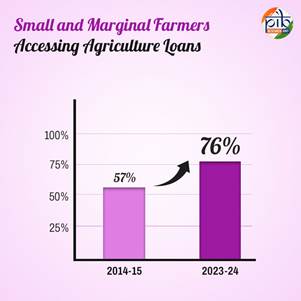
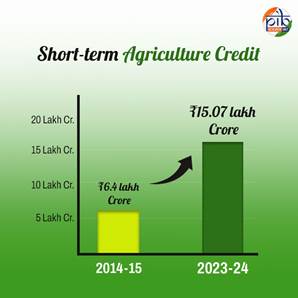
- The proportion of Small and Marginal Farmers accessing agriculture loans grew from 57% in 2014-15 to 76% in 2023-24.
Conclusion
The Kisan Credit Card scheme has been instrumental in transforming agricultural credit accessibility, ensuring that farmers receive timely and affordable financial assistance. By increasing financial support under the Union Budget 2025-26, the government is reinforcing its commitment to empowering farmers. These initiatives not only promote agricultural growth but also enhance rural livelihoods, paving the way for a resilient and self-sufficient farming community in India.
References
Annual Report 2023-24 https://www.agriwelfare.gov.in/en/Annual
https://fasalrin.gov.in/
https://pib.gov.in/PressReleasePage.aspx?PRID=2098424#:~:text=The%20budget%20for%20Department%20of,government's%20commitment%20to%20agricultural%20development.
Economic Survey of India: https://www.indiabudget.gov.in/economicsurvey/index.php
https://static.pib.gov.in/WriteReadData/specificdocs/documents/2024/dec/doc20241219474501.pdf
Transforming Agricultural Finance
***
Santosh Kumar/ Sarla Meena/ Madiha Iqbal
(रिलीज़ आईडी: 2099696)
आगंतुक पटल : 18887